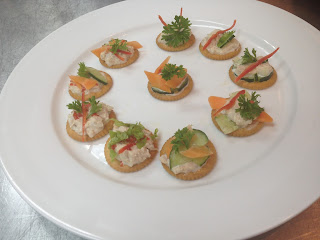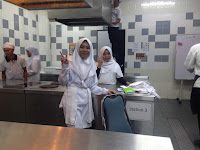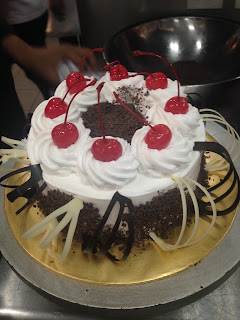CHAPTER 5 - PREPARATION AND SERVING FOOD
CHAPTER
5 – PREPARATION AND SERVIGN FOOD
INTRODUCTION
-
The flow begins with receiving and storage. As foods
delivered directly placed into storage
-
From storage, foods and ingredients are moved or
‘flow’ into the preparation and handling stages of production
-
The preparation and service of foods can involve one
or more steps.
-
Regardless of how many steps may be involved in food
production and service, food borne illness prevention requires effective food
safety measures that ensure good personal hygiene and avoid cross contamination
and temperature abuse.
-
During preparation, an important technique to follow
is ‘small batch’ preparation.
FREEZING
Ä Most harmful
bacteria and other microorganisms do not grow at much colder temperature below
41° F (5 C).
Ä Many spoilage
microorganisms grow at much colder temperatures. Therefore, frozen foods must
be kept solidly frozen.
Ä A parasitic
destruction guidelines that have been established for raw-marinated and
marinated, partially cooked fish.
THAWING
ü Under cool
running water.
ü In a microwave oven followed by immediate
cooking.
ü In a
refrigerator until used temperature never above 41 F°(5°C)
ü As part of the cooking process
COLD
STORAGE
v Frozen, ready
to eat, potentially hazardous foods should be consumed within 24 hours after
thawing whenever possible
v Large amounts
of food are removed from the freezer; they should be marked to indicate the
date by which the food must be consumed.
v A refrigerated,
ready to eat, potentially hazardous foods must be discarded if it:
1) Exceeds the prescribed time and
temperature requirements.
2) Is in container or package that does
not bear a date or day.
COOKING
§ Purpose of
cooking is to make food more palatable by changing its appearance, texture and
aroma.
§ Cooking also
heats the food and destroy harmful microorganisms that may be found in and on
the product.
§ Raw animal
foods need to be cooked to the proper temperatures to be safe.
|
Food Type
|
Minimum Internal
Temperature
|
Minimum Time Held
at Internal Temperature Before Serving
|
|
Beef Roast (Rare)
|
54°C
60°C
|
112 sec
12 min
|
|
Eggs, Beef and Pork (other than roast), Fish
|
63°C
|
15 sec
|
|
Ground Beef, Ground Pork and Ground Game Animal
|
68°C
|
15 sec
|
|
Beef Roast (medium) and Ham
|
63°C
|
4 min
|
|
All Poultry, Stuffed meats
|
74°C
|
15 sec
|
COOLING
·
After proper cooking, foods need to be cooled from
60°C to 5°C as rapidly as possible.
·
Always use a thermometer to verify foods are cooling
properly.
â Methods for
reducing cooling time:
v Use containers
that facilitate heat transfer (stainless steel)
v Transfer food into shallow pans that will allow for
product depth of 3 inches or less
v Transfer food
into smaller containers
v Stir food while
cooling
v Place
containerized food in an ice water bath
v Stir food in a
container placed in an ice water bath
v Use cooling
paddles to stir the food
v Add ice
directly to a condensed food
COLD-HOLDING,
HOT-HOLDING AND REHEATING
Ä Have been
cooked and are intended to be held hot (not cooled, stored and reheated) must
be maintained at 60°C or above
Ä Cold-holding is
holding potentially hazardous foods which are to be consumed cold at 41 F (5
C).
Ä Hot-holding is
holding potentially hazardous foods above 135 F (57 C) during transportation
and delivery to any site away from the primary preparation to service areas
Ä Proper holding
temperatures slow down or prevent the growth of harmful microorganisms.
Ä During hot-holding,
never add fresh product to existing product and always work in small batches.
Ä Reheat to at
least 74°C within two hours.
Ä Foods can be
reheated in smaller quantities or by using preheated ingredients
SERVING
SAFE FOOD
Ø When serving
food always practice good personal hygiene
Ø Use tongs,
serving spoons, disposable gloves or deli tissue when handling foods.
Ø Employees must
hold serving utensils by the handle only and they must never touch the part of
the utensil that comes into contact with food
Ø Always store
serving utensils in a way that permits the employee to grab the handle without
touching the food



Comments
Post a Comment